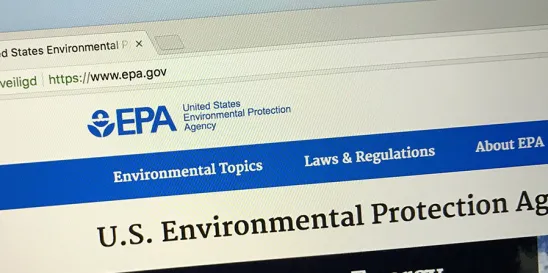On September 28, the Environmental Protection Agency (EPA) posted a final rule that will require any entity that has manufactured or imported per- and polyfluoroalkyl substances (PFAS) in any year since 2011 to report detailed information on PFAS usage, production volumes, disposal, exposures, and hazards.
EPA’s final rule can be found here.
The rulemaking is the latest in a series of efforts nationwide to regulate and gather information about PFAS and PFAS-containing products (e.g., Maine’s PFAS notification requirements). The who, what, how, where, and when are outlined below.
Who?
The reporting and recordkeeping requirements apply to any person who has manufactured for commercial purposes any PFAS or mixtures containing PFAS in any year since January 1, 2011. A manufacturer is a person who imports, produces, or manufactures PFAS. An importer is any person who imports any PFAS or PFAS as part of a mixture or article into the customs territory of the US, including the person primarily liable for the payment of any duties on the merchandise, the consignee, and the importer of record.
The rule defines PFAS somewhat broadly to cover any chemical substance or mixture containing a chemical substance that contains at least one of the following three structures:
-
R-(CF2)-CF(R’)R’’, where both the CF2 and CF moieties are saturated carbons;
-
R-CF2OCF2-R’, where R and R’ can either be F, O, or saturated carbons; and
-
CF3C(CF3)R’R’’, where R’ and R’’ can either be F or saturated carbons.
According to EPA, at least 1,364 substances meet this definition, the vast majority of which have not yet been evaluated for or shown to cause human or environmental risk. The agency will be providing a non-exhaustive list of substances that meet this definition of PFAS on its CompTox Chemicals Dashboard.
Though the rule broadly applies to a wide variety of entities, its reporting requirements do not apply to either entities that import municipal solid wastes for the purpose of disposal or destruction of PFAS or a federal agency that imports PFAS for something other than a commercial purpose.
What?
Reporting entities are required to submit the following information to EPA:
-
Company information, including information about each site at which a reportable PFAS is manufactured;
-
Common or trade name, chemical identity, and molecular structure of each PFAS or mixture manufactured or imported;
-
Categories or proposed categories of use for each PFAS or mixture;
-
Total amount of each PFAS or mixture manufactured or processed, the amounts manufactured or processed for each category of use, and reasonable estimates of the respective proposed amounts;
-
Descriptions of byproducts resulting from the manufacture, processing, use, or disposal of each PFAS or mixture;
-
All existing information concerning the environmental and health effects of each PFAS or mixture;
-
The number of individuals exposed, and reasonable estimates on the number of individuals who will be exposed, to each PFAS or mixture in their places of work and the duration of their exposure; and
-
The manner or method of disposal of each PFAS or mixture.
If a reporting entity has already submitted some of the required information to EPA under a different reporting program (e.g., the Chemical Data Report Rule, Greenhouse Gas Reporting Rule, Toxics Release Inventory Reporting Rule), it will not need to re-report that information to EPA. Companies must maintain the records that document the information reported to EPA for five years.
How?
A reporting entity must report the above information to the extent it is “known to or reasonably ascertainable” by them. This includes “all information in a person’s possession or control, plus all information that a reasonable person similarly situated might be expected to possess, control, or know.” Thus, a reporting entity must undertake a certain level of due diligence in order to evaluate their current level of knowledge of their manufactured products and imports and assess whether additional information exists that a reasonable person, similarly situated, would be expected to know, possess, or control.
EPA advises that a reporting entity must conduct a reasonable inquiry within the full scope of their organization and may also need to inquire outside their organization to fill gaps in the submitter’s knowledge, such as by sending inquiries to upstream suppliers, downstream users, or employees or other agents of the manufacturer, including persons involved in the research and development, import or production, or marketing of the PFAS. EPA considers the following information to be “known to or reasonably ascertainable by” the manufacturer: (1) files maintained by the manufacturer, such as marketing studies, sales reports, or customer surveys; (2) information contained in standard references showing use information or concentrations of chemical substances in mixtures, such as a supplier notification or safety data sheet; and (3) information from the Chemical Abstracts Service or from Dun & Bradstreet. However, information that cannot be derived or reasonably estimated without conducting further customer surveys would not be “reasonably ascertainable” to the manufacturer, and the rule would not require such manufacturer to conduct new surveys for purposes of the rule.
In addition, if actual data is requested and no actual data is known or reasonably ascertainable, a reporting entity may submit “reasonable estimates,” which can rely on approaches such as emissions factors, mass balance calculations, or best engineering judgment.
Where?
The required information must be submitted to EPA electronically via the agency’s electronic reporting site, the Central Data Exchange.
When?
The required information must be submitted no later than 18 months following the publication of the final rule in the Federal Register.
The information submitted to EPA under this program will likely be used to inform future PFAS regulatory and enforcement activity. Because the reporting requirements are onerous, businesses should not delay in evaluating their PFAS manufacturing and importing activities and gathering required information and documentation.





 />i
/>i
